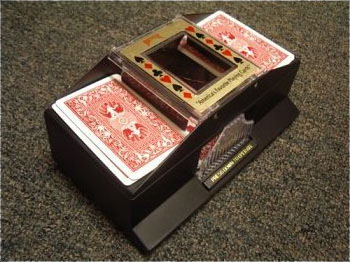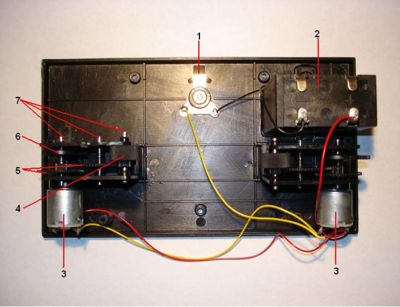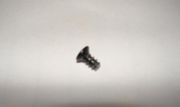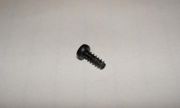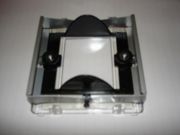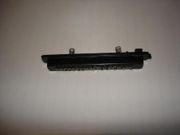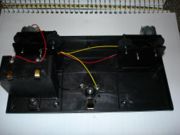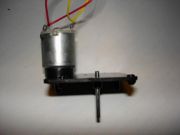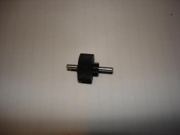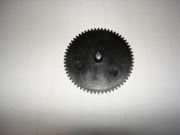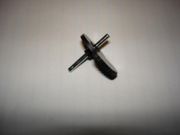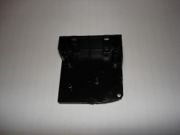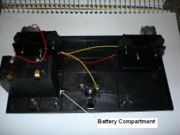Automatic card shuffler
From DDL Wiki
(→Customer Needs/Requirements) |
|||
| Line 61: | Line 61: | ||
=How the System Functions= | =How the System Functions= | ||
| + | [[image:Team04_LabeledDiag.JPG|left|400px|[[help:contents|demo]]]] | ||
| + | |||
| + | |||
| + | |||
| + | |||
| + | |||
| + | |||
| + | |||
| + | |||
| + | |||
| + | |||
| + | |||
== Function: == | == Function: == | ||
Revision as of 02:41, 8 March 2007
Contents |
Executive Summary:
The primary purpose of the Automatic Card shuffler originally was to take away the burden of one shuffling cards in a card game. What usually takes place in a card game is that players would take turns shuffling the deck of cards in order to rearrange the previous order that the cards were in. This action was to ensure that each player recieves an even hand when the cards are dealt out evenly. Now assuming that we live in an ideal world, the cards would be shuffled evenly so that neither player wouldn't have an unfair advantage. In reality the chances of the cards being shuffled evenly on a consistent basis are very slim. One factor could be the simple fact that some people cannot shuffler as good as others. Furthermore some people cannot not shuffle at all. As a result, there isn't really a pattern that the deck of cards follow after a person shuffles them due to human error. This human error is the result of poorly shuffled cards because of a lacking in the ability to shuffle cards effeciently. The deck might still have particular cards together prior to the shuffle as a result of human error. The Automatic Card shuffler serves if not to completely eliminate, then reduce this error as much as possible.
The basic functionality of the automatic card shuffler is to take one or two decks and alternately shuffle them into a central holding compartment. It is powered by two “C” batteries which are connected in series to the motors and gear trains. The on/off switch consists of a spring loaded button that depresses a curved piece of sheet metal, which in turn completes the circuit. The motor and gear train mechanism rotate a rubber wheel which pulls cards alternately from both sides on top of the shuffler. After all the cards have been shuffled, the user can then slid out the plastic holder and reinsert the cards to the top and reshuffle if desired.
The assembly of the product involves various manufacturing processes. The gears, which transfer rotational motion from the motor to the rubber wheels on top, were made through an injection molding process. The outer shell/casing, which holds the cards during pre/post shuffling were likely also made through an injection molding process. Afterwards, the individual pieces were probably glued and finally a CNC mill cut out the rectangular holes throughout the body. The plastic viewing screen on top was most likely made through injection molding while the attached metal sides were probably made by stamping. Overall, the manufacturing aspect of the shuffler has been optimized fairly well and we feel there isn't much to be improved upon with regards to cutting costs or simplifying the manufacturing process.
In terms of product flaws, we noticed that some could easily be modified and corrected. By doing marketing research, analyzing design and survey, we have gotten alot ideas for putting new design along with more useful features on the existing product. Our goal here is to make the shuffler more functionable and convenience, make it become one of good friends whenever there is a card game. We have determined that consumers of this product generally want something that can help not only the shuffling aspect of cards, but will serve other functions to all aspects of improving the quality of playing cards games. One recommedation we have is to include holding slots for other decks of cards or dice. Another idea is to include a score tracker either electronic or physical. Things like these can be implemented without too much increase in cost or manufacturing and would enhance the performance of the shuffler.
We have come up with a key areas of improvement that we feel should be focused upon with respect to the design of the shuffler. In our research we received a lot of complaints that the shuffler was very noisy when operated and we think a simple solution to this would be to include some kind of dampening material to the product where the cards hit the side walls when they get shuffled to muffle the noise. Another area for improvement is the output tray slot. We noticed that it took more effor than necessary to remove the cards after they have been shuffled since the output slot is recessed in the shuffler as well as behind the operating button. Moving the operating button and exposing the output tray more would solve this problem. Another key area that we feel which could use improvement is the randomness of the shuffle. We have done research that shows that the card shuffler shuffles very consistantly which could result in an easy prediction of the outcome of shuffling. We have proposed our top designs below in the report to address these issues.
Customer Needs/Requirements
There are certain customer needs which the automatic card shuffler should perform: speed of shuffling, battery life, easy to use, the quality when shuffling, adequate level of mixing, features, price and durability. It has to be carefully designed for quality purpose in order to reach higher level of performance with lower manufacturing cost and time consuming. As they can generate biased shuffles otherwise cards produced from automatic shuffling machines is the subject of considerable interest to both gamblers and casinos.
Since some people who don’t know how, lazy to shuffle, shuffle too slowly or can’t shuffle. The shuffler needs to be easy to use and the procedure of working with product should take less effort than doing by hand. Also, it should also shuffle/process faster than average processing time by human’s hands. For the senior users, it would help to save the time of learning and reading the user’s manual, reduces the cost of time on shuffling to enjoy their card games.
When people buy it, price will become an issue. Since the product cost around $10, we are here to look for the product with lower cost and higher value, higher durability. The durability can be divided into two categories, mechanical and electrical. Right now most of the shufflers out there are made by plastic with vulnerable components, the mechanical parts are what cause the most failure of the machine.
For continuous use over the maximum amount of time the batteries and environmental effect after using batteries, the design of the automatic card shuffler needs to be focus on how to make the battery less consumable. There could be other smaller battery, human hand power or even solar power can be substituted. In addition, we will need the product become easy to carry and store. The smaller size, lighter weight and feasible structure of product will make it more accessible by users.
The automatic card shuffler mimicked people, cutting the deck and interlacing cards to perform riffle shuffles. Typically, an automatic card shuffler pulls cards one by one from the bottom or top of a deck and slides each card into one. Most of the card games require cards to be shuffled randomly which means the shuffler has to perform great randomness of final product. “Is it fair to use card shuffler?” This has recently become a really popular research topic by people since more and more people live their life in the card game. If the cards aren't properly shuffled and their distribution isn't truly random, the advantage could be even greater
List of Customer Needs and Product Requirements
| List | Customer Needs | Product Requirements |
|---|---|---|
| 1 | Easy to Use | Overall Design |
| 2 | Save Time | Speed of Processing |
| 3 | Randomness | Shuffling Design |
| 4 | Easy to Carry/store | Light Weight/Smaller Size/Good Structure |
| 5 | Durability | Mechanical Design/Battery Life |
| 6 | Features/Functions | More Accessories |
| 7 | Price | Lower Cost to Manufacture |
| 8 | Quality of Shuffling | Make Less Noise |
How the System Functions
Function:
The purpose of the automatic card shuffler is to shuffle one or two decks of playing cards. It is used to simplify the overall shuffling process, and to take out the human error aspect of shuffling. People who are playing a card game such as poker or blackjack can use the automatic card shuffler to substitute for hand shuffling. The shuffler is meant to speed up the shuffling process and provide the ability to shuffle cards for those who can't shuffle. The device also eliminates the possibility of someone cheating while shuffling or shuffling with error. The automatic card shuffler will also stack the cards into a neat pile ready to be dealt out in a game. The product will also speed up the overall gameplay as people will not have to take turns while shuffling the cards. The card shuffler also reduces wear on the cards since the shuffling process does not involve bending of the cards.
Inputs/Outputs
The input of the automatic card shuffler is the placement of the cards into the two card holding slots. The user then starts the device by pressing down on the trigger switch. When depressed, this switch will complete a ciruit that connects the batteries to two small motors that spin at high speed. The motors are small and produce high speed but with little torque so gears are used to gear down the speed while increasing the torque applied to the cards. The gears are connected to a wheel which draws the cards from the two card holding slots into the middle output slot. The motor will continue to run and the wheels will spin until the lever is released. The user then retreives the cards from the middle output slot to use or to repeat the shuffling process by placing the cards back into the two card holding slots.
Use and Operation
To operate the card shuffler, the user must first place two "C" batteries into the battery compartment located beneath the shuffler. This involves removing the phillips screw that secures the battery compartment cover and then placing the batteries in and replacing the cover. The card shuffler should then be placed on a flat surface so that the cards placed into the machine will fall evenly. The user can then place one or two decks of cards into the two card holding slots located on the sides of the shuffler. The user preferably should place even stacks of cards into each side of the card holding slots to ensure even shuffling. Then the removeable tray should be placed into the output slot so that the shuffled cards can be removed easily. To start the shuffling process, the user will then depress the power switch located at the front base of the device. The user should continue pressing the button until all the cards have been shuffled. When the shuffling is complete, the user can then remove the tray along with the cards. The cards can then be used or replaced into the machine again to reshuffle the cards further.
Different Use/ Use Scenarios
The automatic card shuffler can be used to shuffle cards for different reasons associated with playing card games. There are many different games which require shuffling of the cards after each round such as poker, spades, speed, or blackjack. The device will primarily be used when playing card games with groups of people such as at parties or small get togethers. Some improper use of the device could result by using cards which are non-standard size or thickness. Using it for any other use other than to shuffle cards is not consistant with the original purpose.
Product Dissection
Before we tested the card shuffler, we took it apart in order for us to see how the shuffler functions and made the following assumptions:
1. There are two gear train systems.
- One motor is driven by batteries, which in return powers the other motor.
- The two motors are connected to each other by two wires.
2. Each gear train has its own motor.
3. For syncronization, there are two modified gears, both of which have teeth on some portion of itself.
4. One of the modified gears has its teeth pointing down, while the other modified gear has its teeth pointing up.
5. We assumed this was important because when a person places cards on both the left and right side of the card platform, one card would be lifted up while the other would be touching the surface of the card platform.
6. The card that remains in contact with the surface of the card platform is carried by a fat gear that is driven by a motor when the user presses the shuffle button.
7. This motor is powered by two "C" batteries.
8. After this card carried into the center slot with the tray, the modified gears are now in alternate positions, and the same process is repeated for the other card on the other side of the card shuffler.
List of Parts
| Part # | Part name | QTY | Function | |
|---|---|---|---|---|
| 001 | Small Screws | 4 | Holds top plastic screen in place | |
| 002 | Medium Screws | 3 | Located on bottom of case in triangular formation, under the card tray | |
| 003 | Large Screws | 8 | Located along other perimeter on botom of case, to hold case together/hold the gear train case | |
| 004 | Clear Top Cover | 1 | Located on top of case in between card decks, provides slot for them to slide through. Also, keeps the rest of the deck in place while shuffling is in progress | |
| 005 | Operating Button | 1 | Contacts metal piece beneath to complete circuit allowing both motors to operate | |
| 006 | Circuit Wire | 5 | Setup in series and connected to the battery. Circuit completed when part 005 is pushed and held down | |
| 007 | Motor | 2 | Initiates the power to make the gears rotate in order to shuffle the cards | |
| 008 | Rubber Gripper | 2 | Increases the friction force to grab the cards into the tray | |
| 009 | Spur Gear | 2 | Changes the direction of gear rotation and creates more torque | |
| 010 | Offset Gear | 2 | Makes contact with deck of cards from underneath | |
| 011 | Gear Case | 1 | Covers and protects the gear train mechanism | |
| 012 | Battery Compartment | 1 | Transfers the electrical power into mechanical power |
DFMA
Manufacture Analysis - After taking apart the product it was easily seen how most of the parts were made. Also, because of the fact that it is a relatively cheap item, almost everything was injected molded. Three different sized screws were used to assemble the whole product, where many of them posed a large problem when trying to get them out. The motor was probably the only component that the maker did not manufacture. As for the shape and various cutouts, a type of CNC milling process was used.
Disassembly/Assembly Analysis - The clear top cover of the shuffler is held together by the small screws and does not need to be removed in order to access the internal mechanisms. The medium screws are located on the outer perimeter on the bottom of the case, while the large screws are also located around the perimeter and also are used to hold the gear train in place. After taking them out, which was very difficult due to their size and how they were torqued, we realized that having so many screws was unecessary since the case does not go through that much stress.
Ideas For Improvement - Noticing the large number of screws used to hold the case together we thought of two options; one of which would be to reduce the number of screws in total and the other would be a snap type mechanism, elimnating the screws. Both of these would reduce manufacturing cost. The compartment that holds the cards after they are shuffled is also badly placed. It was very difficult for a normal sized hand to reach in and pull the cards. Even after trying to slide the cards out, they were being blocked by the spring loaded operating button. Moving the button to either the left of right side of the case and having the compartment slightly inclined would greatly help in accessing the cards. In turn this would also help in terms of shuffling speed so as to create minimal downtime/waiting during a card game.
Design for Environment
Our major area about the impact of environment and the automatic card shuffler are batteries and the plastic body decompositions after throwing away.
In order to run the current automatic card shuffler, users will need to insert two "C" batteries. Most users will choose the non-rechargeable batteries to save the cost. After using for couple times, we need to buy and change another two batteries. Batteries contain hazardous materials that may get into the environment. For example, cadmium and lead enter soil and water from landfills and enter the air via municipal waste incinerators. Recycling the batteries has become an issue to normal users since it is not as easy as a can of soda. Batteries can be recycled at the household Waste collection facility which may not be convenient for most users. This will result people just throw it directly without recycling. Using the automatic card shuffler without batteries will be a positive impact for the environment.
After users decide not to use the automatic card shuffler and throw it away, that is another potential to takes up space in landfills and become harmful to environment. Since plastics are so durable that they will not rot or decay as do natural products such as those made of wood. As a result great amounts of discarded plastic products accumulate in the environment as waste. It also presents the additional problem of being difficult to burn. We think by using the better material to help by producing less pollution is an important are for our product
Failure Mode and Effects Analysis
The following chart emphasizes the most sever failures that can occur with the product. Although none of these failures could cause a complete termination of the functionality of the product, they would cause the user to become completely dissatisfied with the product, thus coercing the user to stop the usage of the card shuffler. The point of this analysis is to ensure that the user is free from as many annoyances that would cause he /she to stop using the product.
| Item & Function | Failure Mode | Effects of Failure | S | Causes of Failure | O | Design Controls | D | RPN | Recommended Actions | Responsibility & Deadline | Actions Taken | S* | O* | D* | RPN* |
|---|---|---|---|---|---|---|---|---|---|---|---|---|---|---|---|
Motor
| Electrical failures: Motor may not output consistent power | Product shuffles cards in an inconsistent pattern resulting in uneven shuffling. | 7 | Poor brand of motor. Poor connections between the motor and the wires. | 7 | Extensive testing in various conditions because environment setting could play a role | 3 | 147 | More effort in making more secure connections. Integrate better motors | Motor Manufacturer | N/A | 7 | 5 | 3 | 105 |
| Mechanical Failures: Wear & Tear. | Loud noise and inefficient shuffling of cards . | 7 | Heat generation causing the teeth in the gears to deform and shear away at each other | 2 | Test in various conditions and record temperature with thermocouples | 6 | 84 | Change arrangement of gears to reduce power input required of motor | Motor manufacturer | N/A | 6 | 2 | 5 | 60 | |
Gear train
| Gear train is not snugged fit. Loose gears. | Gears produce loud noise that is intolerable for the user. | 8 | Broad range for the dimension tolerance. | 8 | Run the gears to check for wobbling | 6 | 384 | Reduce the tolerance range for the teeth dimensions of the gears | Manufacturer | N/A | 5 | 6 | 5 | 150
|
Gear Train Case
| Vibration on the card shuffler | Wobbling of gears because the entire gear train set is vibrating. | 7 | Case not secure to the base of the card shuffler. | 7 | Test to see required force to hinder vibration | 5 | 245 | Glue the gear case to the base | Manufacturer | N/A | 7 | 5 | 3 | 105 |
Conducting Wire
| Unsteady power output | Inconsistent rotating of the gears. | 5 | gauge size of wire may not be sufficient enough. | 7 | Test with different wire types | 3 | 105 | Use bigger gauge of wire | Motor Manufacturer | N/A | 4 | 6 | 3 | 72 |
Market Reasearch and Observations
our market research and things we found out will go here.
Further Analysis and Conclusions
what we summarize about the product will go here. include what direction we want to go with regards to improving the product
Top Design Concepts
Click the link below to go to our concepts page.
